The AMD A8-7650K APU Review, Also New Testing Methodology
by Ian Cutress on May 12, 2015 10:00 AM ESTGaming Benchmarks: Low End
Alien: Isolation
If first person survival mixed with horror is your sort of thing, then Alien: Isolation, based off of the Alien franchise, should be an interesting title. Developed by The Creative Assembly and released in October 2014, Alien: Isolation has won numerous awards from Game Of The Year to several top 10s/25s and Best Horror titles, ratcheting up over a million sales by February 2015. Alien: Isolation uses a custom built engine which includes dynamic sound effects and should be fully multi-core enabled.
For low end graphics, we test at 720p with Ultra settings, whereas for mid and high range graphics we bump this up to 1080p, taking the average frame rate as our marker with a scripted version of the built-in benchmark.
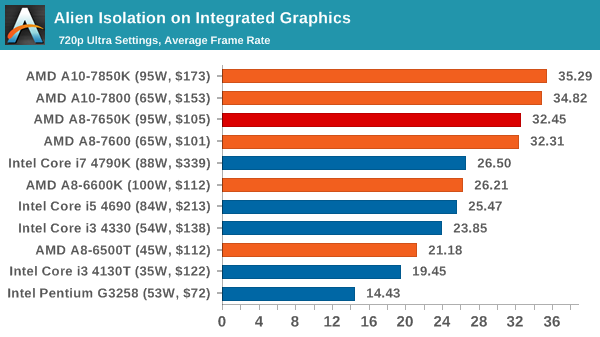
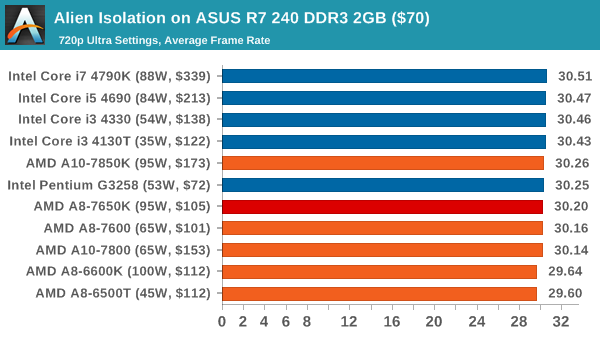
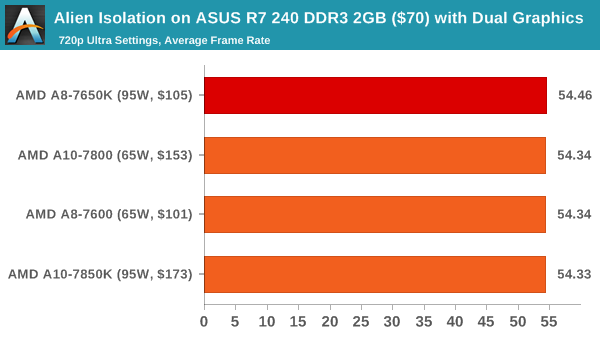
When it comes to integrated graphics, the APUs are ruling the roost. The A8-7650K sits in its stack where it should, between the A10-7800 and the A8-7600. When we use a low end GPU, all our CPUs perform similarly showing that this benchmark is more GPU limited at this level. In Dual Graphics mode, the frame rate moves up to just under double the integrated value.
Total War: Attila
The Total War franchise moves on to Attila, another The Creative Assembly development, and is a stand-alone strategy title set in 395AD where the main story line lets the gamer take control of the leader of the Huns in order to conquer parts of the world. Graphically the game can render hundreds/thousands of units on screen at once, all with their individual actions and can put some of the big cards to task.
For low end graphics, we test at 720p with performance settings, recording the average frame rate. With mid and high range graphics, we test at 1080p with the quality setting. In both circumstances, unlimited video memory is enabled and the in-game scripted benchmark is used.
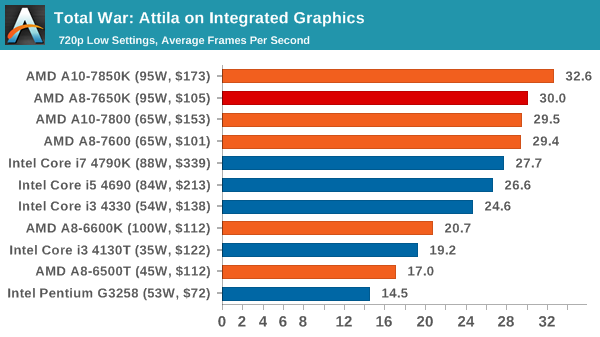
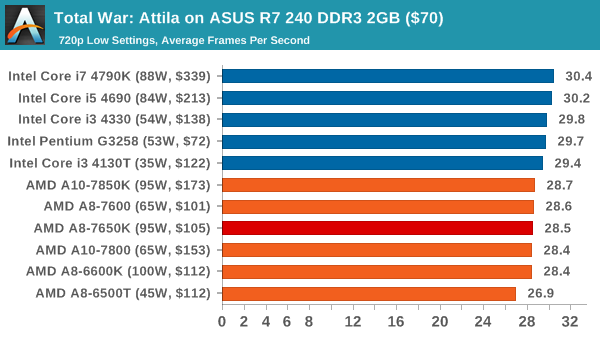
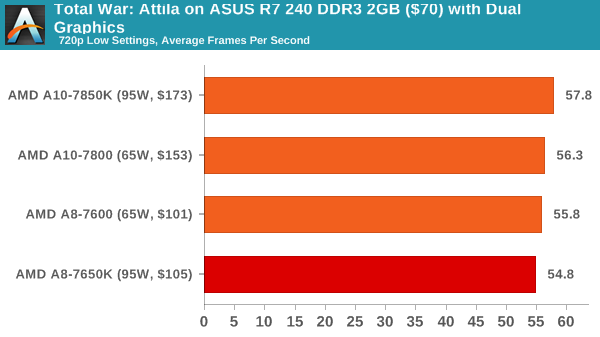
Similarly with Attila, the AMD APUs at $100 beat an Intel IGP at $340. When we move to the R7 240 however, the Intel CPUs actually have a slight advantage, perhaps showing that Attila needs CPU performance here. Again, dual graphics mode offers almost double the frame rate, almost hitting 60 FPS.
Grand Theft Auto V
The highly anticipated iteration of the Grand Theft Auto franchise finally hit the shelves on April 14th 2015, with both AMD and NVIDIA in tow to help optimize the title. GTA doesn’t provide graphical presets, but opens up the options to users and extends the boundaries by pushing even the hardest systems to the limit using Rockstar’s Advanced Game Engine. Whether the user is flying high in the mountains with long draw distances or dealing with assorted trash in the city, when cranked up to maximum it creates stunning visuals but hard work for both the CPU and the GPU.
For our test we have scripted a version of the in-game benchmark, relying only on the final part which combines a flight scene along with an in-city drive-by followed by a tanker explosion. For low end systems we test at 720p on the lowest settings, whereas mid and high end graphics play at 1080p with very high settings across the board. We record both the average frame rate and the percentage of frames under 60 FPS (16.6ms).
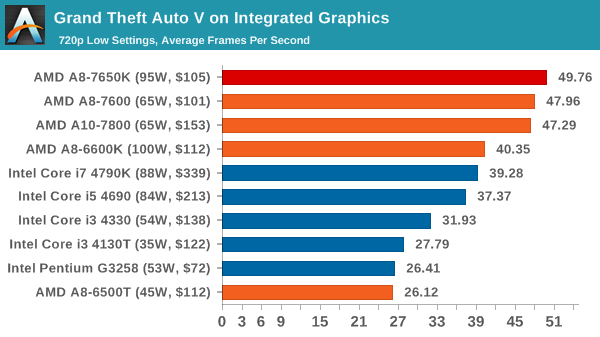
![Grand Theft Auto V on Integrated Graphics [Under 60 FPS]](https://images.anandtech.com/graphs/graph9217/74212.png)
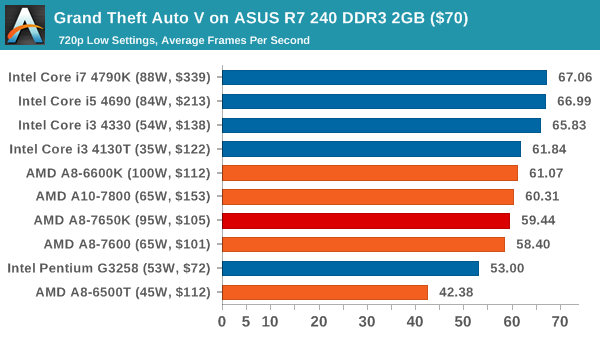
![Grand Theft Auto V on ASUS R7 240 DDR3 2GB ($70) [Under 60 FPS]](https://images.anandtech.com/graphs/graph9217/74220.png)

![Grand Theft Auto V on ASUS R7 240 DDR3 2GB ($70) with Dual Graphics [Under 60 FPS]](https://images.anandtech.com/graphs/graph9217/74228.png)
One of the surprises in this review, for me, was the GTA performance. Here we have a $105W APU that easily breaks through the 30 FPS barrier in our low GPU setting, almost hitting 50 FPS average. the graph on the right shows the percentage of frames under 60 FPS (or over 16.6 ms), and it's clear that at these settings more horsepower is needed. Using the R7 240 gave a slightly different story, although the $105 APU is inbetween the $72 and $122 Intel CPUs.
GRID: Autosport
No graphics tests are complete without some input from Codemasters and the EGO engine, which means for this round of testing we point towards GRID: Autosport, the next iteration in the GRID and racing genre. As with our previous racing testing, each update to the engine aims to add in effects, reflections, detail and realism, with Codemasters making ‘authenticity’ a main focal point for this version.
GRID’s benchmark mode is very flexible, and as a result we created a test race using a shortened version of the Red Bull Ring with twelve cars doing two laps. The car is focus starts last and is quite fast, but usually finishes second or third. For low end graphics we test at 1080p medium settings, whereas mid and high end graphics get the full 1080p maximum. Both the average and minimum frame rates are recorded.
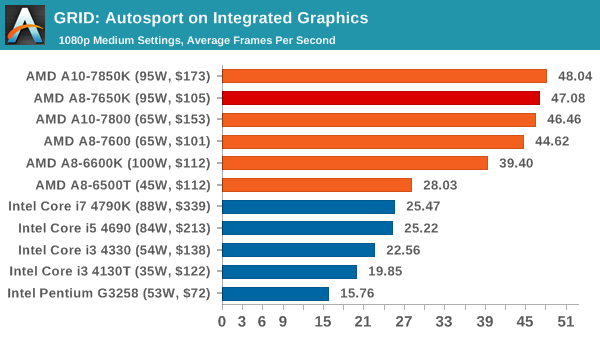
![GRID: Autosport on Integrated Graphics [Minimum FPS]](https://images.anandtech.com/graphs/graph9217/74214.png)
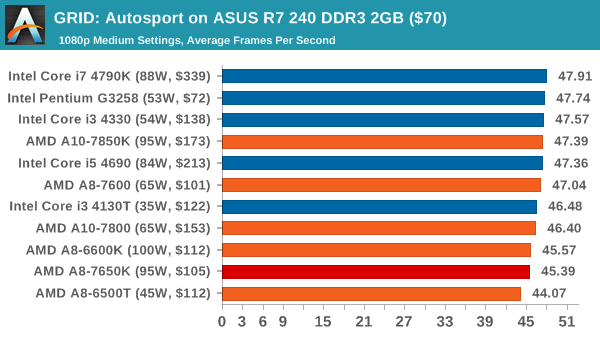
![GRID: Autosport on ASUS R7 240 DDR3 2GB ($70) [Minimum FPS]](https://images.anandtech.com/graphs/graph9217/74222.png)
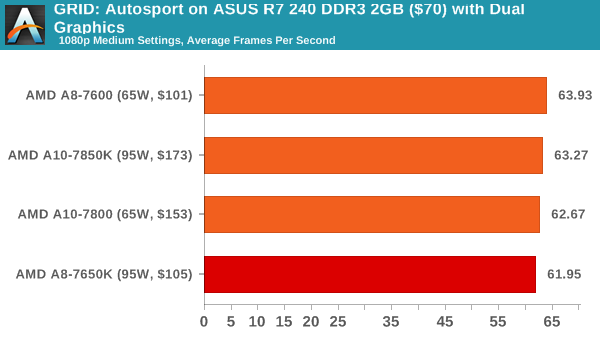
![GRID: Autosport on ASUS R7 240 DDR3 2GB ($70) with Dual Graphics [Minimum FPS]](https://images.anandtech.com/graphs/graph9217/74230.png)
Codemaster's racing engines historically like as much as can be thrown at it, and on integrated graphics it is a clear win for AMD's parts, getting almost double the frame rate. This was perhaps expected, knowing how AMD partitions more of its die area to graphics. When we stick in the R7 240, the difference becomes negligable, and only a small rise is seen from dual graphics.
Middle-Earth: Shadows of Mordor
The final title in our testing is another battle of system performance with the open world action-adventure title, Shadows of Mordor. Produced by Monolith using the LithTech Jupiter EX engine and numerous detail add-ons, SoM goes for detail and complexity to a large extent, despite having to be cut down from the original plans. The main story itself was written by the same writer as Red Dead Redemption, and it received Zero Punctuation’s Game of The Year in 2014.
For testing purposes, SoM gives a dynamic screen resolution setting, allowing us to render at high resolutions that are then scaled down to the monitor. As a result, we get several tests using the in-game benchmark. For low end graphics we examine at 720p with low settings, whereas mid and high end graphics get 1080p Ultra. The top graphics test is also redone at 3840x2160, also with Ultra settings, and we also test two cards at 4K where possible.
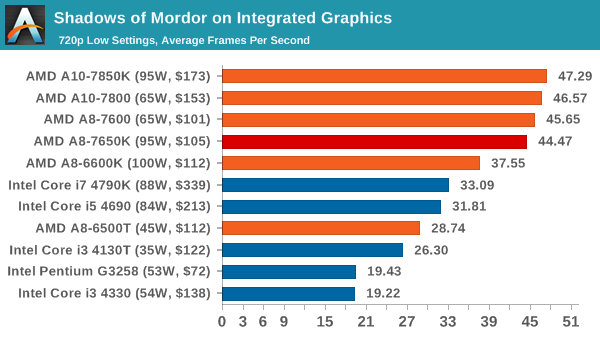
![Shadows of Mordor on Integrated Graphics [Minimum FPS]](https://images.anandtech.com/graphs/graph9217/74216.png)
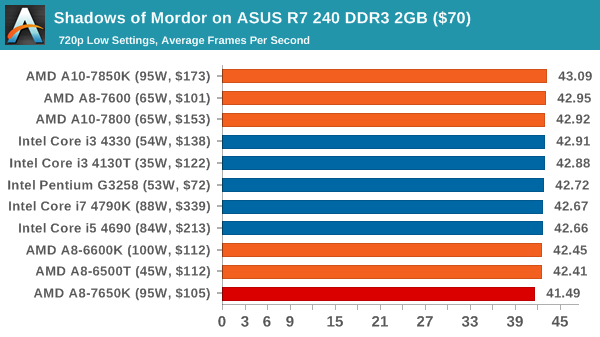
![Shadows of Mordor on ASUS R7 240 DDR3 2GB ($70) [Minimum FPS]](https://images.anandtech.com/graphs/graph9217/74224.png)
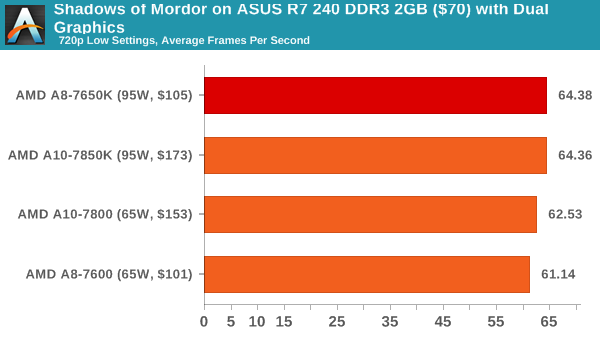
![Shadows of Mordor on ASUS R7 240 DDR3 2GB ($70) with Dual Graphics [Minimum FPS]](https://images.anandtech.com/graphs/graph9217/74232.png)
Similar to GRID, Mordor loves the integrated graphics with a clear margin from Intel to AMD in average frame rate and minimum frame rate. With the R7 240, all GPUs are more-or-less equal, although Intel has the upper hand in minimum frame rates. Dual graphics mode gives a good boost to the average frame rates, moving from 44 FPS to 64 FPS on the A8-7650K.















177 Comments
View All Comments
xprojected - Tuesday, May 12, 2015 - link
Mid-range:- MSI GTX 770 Lightning 2GB ($245-$255 on eBay/Amazon, $330 new)
- MSI R9 285 Gaming 2GB ($240)
Hold on. You suggest that the 770 and the 285 are nearly the same price, but you list the used/refurbished price for the 770 first. That opens up a Pandora's box, doesn't it? If it's too hard to find a card new, pick a different one, like the 970, or 960, which is actually close in price to the 285 (at least a couple go for $200 on Newegg). Even though you say you split the GPUs based on price ranges, rather than similar prices, people are going to compare ATI to NVidia and you have an unfair used-vs-new price comparison.
Ian Cutress - Wednesday, May 13, 2015 - link
Ideally the tests are meant to show comparisons within a GPU class, not between GPU classes. Ultimately I work with the cards I have, and on the NV side I have a GTX 980 and a GTX 770, whereas on the AMD side is an R9 290X and R9 285 (the latest Tonga). In comparison to what I have, the 980/290X are high end, and the 770/285 are a class below. The 770 Lightning is also hard to source new, due to its age, but is still a relevant card. If I could have sourced a 960/970, I would have.Navvie - Wednesday, May 13, 2015 - link
That is one of the things that really puts me off AT these days. The attitude of "this is what I have available, this is what I'll test against." If it's not relevant don't use it. Get out the AT credit card and buy some new hardware.milkod2001 - Wednesday, May 13, 2015 - link
if they want to spend more money they will have to make more money first.To make more money they would have to spread million annoying ads and this site would quickly turned into Toms super boring "best SSD for the money" articles like, with millions amazon, newegg links, ads and all that crap
They better use what they have in disposal and try to maintain still decent enough articles, reviews etc.
MrSpadge - Tuesday, May 12, 2015 - link
"Despite the rated memory on the APUs being faster, NPB seems to require more IPC than DRAM speed."Guys.. the Intel chips have better memory controllers since many years. They extract much higher performance and lower latency if you compare them at similar DRAM clock & timings. Lot's of AT benchmarks showed this as well, back when such things were still included (e.g. when a new architecture appears).
rp1367 - Tuesday, May 12, 2015 - link
Here we go again, this is another pro Intel review. The crooked company who paid AMD Billion $ settlement case due to unfair competition practices are still being supported by lots of rotten people based on their comments here is disturbing. I find these people scum on this earth as they continue to support the scammers. Shame on you guys!By the way the review is biased as you benchmark it using DX11. This is another manipulative benchmark trying to hold on the past and not on the future. Read my lips "WE DONT WANT DX11 review only! DX12 is coming in a few months why not use the MS Technical review version so people can have a glimpse instead of repeating to us reader, then you redo the benchmark when MS has released its new OS (MS 10). If you dont have full version DX12 now (as we all know) then do not benchmark it bacause it is the same for the past 5 years. You are just wasting your time if your intent is neutral to general consumers as if you are trying to sway us from the truth.
shadowjk - Friday, May 15, 2015 - link
Speak for yourself. What use to me are benchmarks of APIs I don't have and can't get, of games I don't have and don't play. With this latest review method change, the last game I had disappeared, so now I can't compare the results with my own system anymore. This makes it harder to decide whether this product is a good upgrade over my current system or not.Teknobug - Tuesday, May 12, 2015 - link
Looks like A8 7600 with R7 240 dual gfx is the combination here. I have an A8 7600, so now just need that card.UtilityMax - Tuesday, May 12, 2015 - link
Am I the only poster who is impressed with the performance of the Kaveri parts in the gaming benchmarks?For one, the Kaveri parts virtually eliminate the need for a $70 discrete GPU. If you were thinking of that kind of low-end GPU, might as well buy an APU. Next, the is very little difference or none at all in average FPS under many settings if you use a $240 dedicated GPU, which means that and $200 GPU is still the bottleneck in a gaming system. Only once the benchmarks are run with very high end GPUs, we finally see the superiority of the Haswell parts.
Of course, the business, web, compression, and conversion benchmarks are another story. Except for a few special cases, the APUs struggle to catch a Core i3.
meacupla - Wednesday, May 13, 2015 - link
Yeah, these APUs are certainly a lot better on the CPU front than what they used to be.I think the APU's only downfall is that $72 Pentium G3258 and availability of cheaper (sub $100) H97 motherboards to overclock them on.
A88X FM2+ boards are around the same price as H97 boards, but that $30 saving from cheaper CPU can go into a decent cooler for overclocking.